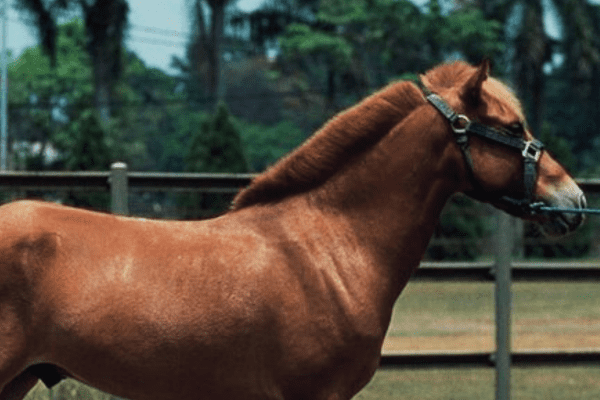The Sandalwood Pony, indigenous to the serene landscapes of Indonesia’s Sumba and Sumbawa Islands, stands as a testament to the region’s rich equine heritage. Named in homage to the illustrious Sandalwood trees that symbolize the nation’s botanical wealth, these ponies are a proud representation of Indonesia’s equine lineage. The breed’s superior stature and remarkable qualities are largely attributed to the infusion of Arabian bloodlines, a factor that elevates their status within the country’s equine circles.
Employed in a variety of roles, from light draft and farm work to riding and pack duties, the Sandalwood Pony demonstrates versatility and resilience. Their prowess is most notably showcased in the realm of horse racing, where they excel in both traditional flat races and the dynamic challenges of harness racing, underscoring their athletic and enduring nature.
History:
The Sandalwood Pony, an esteemed horse breed from Indonesia, boasts an intriguing past laced with cultural connections and historical landmarks. Here we explore this journey that has molded this breed using both historical accounts as well as narrative elegance to weave a fascinating narrative arc.
The Enigmatic Origins
The story behind how horses arrived on Java remains shrouded in mystery.
Early equines may have descended from sturdy breeds found in places like Tibet or Mongolia that excelled at withstanding extreme environments.
Intriguing Tang Dynasty Connections
An intriguing aspect of their history suggests a Chinese influence, particularly during the Tang Dynasty in the 7th century.
As diplomatic gifts, these horses likely made their debut to Indonesian shores as diplomatic presents and graced kingdoms like Dja-va (Kalingga), Dva-ha-la and Dva-pa-tan (Bali).
Mongol Invasion: A Turning Point
The 13th-century Mongol invasion of Java stands as an important historical event, potentially introducing Mongolian horse breeds to the region.
Blending Mongolian horses with local breeds may have laid the groundwork for the Java horse, which became one of the ancestors of Sandalwood Ponies.
Java’s Rise as an Equine Epicenter
Java’s rise as an international horse breeding hub began during the 14th century, when its exports became widely recognized across Asia–even China!
During the Majapahit period, Javanese horse breeds saw significant improvements both in numbers and quality.
The Majapahit Empire’s Legacy
The Majapahit Empire’s expansion had a profound effect on Indonesian archipelago equine dynamics.
Their introduction of Sumbawa horses, believed to have come via Javanese of Majapahit Empire, increased genetic diversity within this region’s horses.
A Tradition of Ornate Equestrianism
Tome Pires, an early 16th century traveler, noted the remarkable ornamentation of Javanese horses decorated with gold and lavish saddles, reflecting their cultural legacy in Indonesia.
Sultans and Their Stables
Sumbawa region under the reign of Bima and West Sumbawa sultans were famous for its abundance of stables indicating a vibrant equine culture. Our current breed, Sandalwood Ponies are descendants of Mongolian horses with influence from them both physically and culturally.
The Genesis of the Sandalwood Pony
The Sandalwood Pony takes its name from the region’s iconic Sandalwood trees and stands as a living representation of this rich history.
This breed represents a harmonious marriage between local Indonesian equine strains and Mongolian horses with lasting qualities.
Conservation and Current Situation:
Conservationists and nature enthusiasts have long been intrigued by this mysterious creature. They champion its cause by advocating for its habitat preservation, emphasizing its value to forest health. The Sandalwood Pony has come to represent ecological awareness as we strive to conserve Earth’s shrinking wilderness areas.

Sandalwood Ponies have long held an allure that transcends their place in folklore; artists and writers find inspiration from its ethereal beauty in creating works that celebrate nature’s relationship to this remarkable creature. Photographers and adventurers look out for any chance they get to capture its image or meet one in the wild – even if those opportunities may only occur occasionally.
In an age when nature’s magic can often go unappreciated, the Sandalwood Pony serves as a constant reminder of all its wonders. He personifies the mystery, beauty, and resilience of forests – reminding us all to reconnect with it and preserve its splendor for future generations.
Not simply an ornamental figure or mythological creature – the Sandalwood Pony serves as an embodiment of hope for us all in connection with nature as an advocate of protection; an ambassador protecting the woods; and witness to all that our planet hides within itself!

